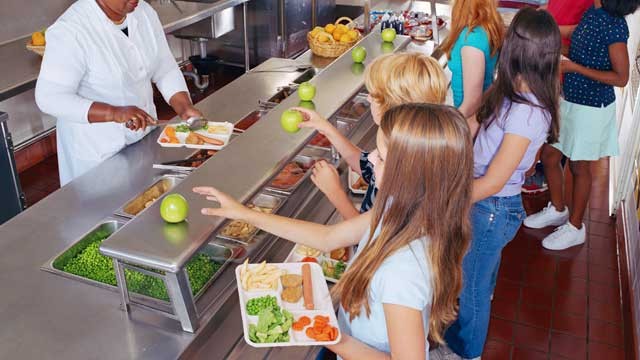ABC's Wednesday Nightline and Thursday's Good Morning America had reports on student rebellion to the new federal regulations on what can be served for lunch.
Watch More News Videos at ABC
|
2012 Presidential Election
|
Entertainment & Celebrity News
By AMY BINGHAM (@Amy_Bingham)
According to Department of Agriculture Secretary Tom Vilsack, the solution to the growing grumbling over re-vamped school lunch menusboils down to a good old fashioned snack.
By AMY BINGHAM (@Amy_Bingham)
According to Department of Agriculture Secretary Tom Vilsack, the solution to the growing grumbling over re-vamped school lunch menusboils down to a good old fashioned snack.
School lunch trays are a bit lighter this year after Congress-approved calorie limits on school lunches went into effect in August. The new regulations, which were championed by First Lady Michelle Obama as part of her "Let's Move" campaign to fight childhood obesity, have inspired protests and even a video parody from students who claim the reduced lunches are making them go hungry.
"It's not surprising that some youngsters will in the middle of the day be hungry," Vilsack told ABC News, responding to the controversy. "I remember my two boys when they came back from school they were always hungry, we always had snacks prepared for them."
Vilsack said the Obama Administration is working with school districts to create snack programs and encouraging parents to pack extra food for their active students to munch on before football practice or band rehearsal.
"We understand that change is difficult," Vilsack said. "Some folks love it, some folks have had questions about it, but that's to be expected when you're dealing with 32 million children and you're dealing with over a hundred thousand school districts."
Under the new regulations, cafeterias are required to serve twice as many fruits and vegetables while limiting proteins and carbohydrates. For an average high school student, that means two baked fish nuggets, a cup of vegetables, half a cup of mashed potatoes, one whole grain roll and 8 ounces of fat free milk is the fuel that served to get them through their last four hours of classes.
But for a grumbling crowd of students, those 750 to 850 calories aren't cutting it.
"We hear them complaining around 1:30 or 2:00 that they are already hungry," said Linda O'Connor, a high school English teacher at Wallace County High School in Sharon Springs, Kansas. "It's all the students, literally all the students... you can set your watch to it."
Melanie Stetson Freeman/The Christian Science Monitor via Getty Images
Students at Doherty Middle School get their... View Full Size
Ban on School Lunch Blogger Overturned Watch Video
Cafeteria 'Boot Camp' Saves School Lunch Watch Video
Government Sets Sights on School Potato Consumption Watch Video
O'Connor teamed up with her hungry students and fellow teacher Brenda Kirkham to create a ballad to the growling stomachs that are now pestering her classroom. The YouTube song and dance video "We Are Hungry," set to the tune of Fun's "We Are Young," now has more than 108,000 hits.
"Give me some seconds, I, I need to get some food today," 16-year-old Wallace County High School football player Callahan Grund sings in the video. "My friends are at the corner store getting junk so they don't waste away."
Vilsack said it was "great" that students were speaking out, but said he had not watched the video.
"I think it's great that kids are creative and I think it's great that they're participating in the process by letting their feelings known and using that format to express themselves," he said.
Across the state at St. Mark's Charter School in Colwich, Kansas, middle school students are protesting the new regulations, which limit their calories to between 600 and 700 per meal, by bringing their lunches from home.
St. Mark's Principal Craig Idacavage said more than half of his 330-student school are opting for sack lunches because "they feel they are not able to get full" on the school offerings.
"I think they have a valid point and you can only hope that people will listen to them," Idacavage said.
The new school lunch regulations, which first lady Michelle Obama championed and a Democrat-led Congress passed in 2010, set a maximum calorie limit for high school lunches at between 750 and 850 calories. Under the old rules, cafeterias served a minimum of 825 calories per lunch.
Elementary students' lunches pack between 550 and 650 calories as opposed to the 633 calories allotted under the old rules.
For Rep. Steve King, R-Iowa, that "scant diet" is a "rude awakening" for schoolchildren across the country. King and Rep. Tim Huelskamp, R-Kansas, introduced the "No Kids Hungry Act" this month to repeal the new lunch menu standards and prohibit the calorie limits.
"Kids are of varying sizes, activity levels and metabolism rates," King wrote in a Des Moines Register op-ed. "How can we expect each child to flourish and grow on subsistence diets? This all because some are overweight."
But it is not just a few overweight kids that are causing calorie cuts across the cafeteria. One out of every four adolescents are too overweight to join the military, according to a report released Tuesday by Mission: Readiness, a group of retired military leaders who claim obesity is now a national security issue.
"Removing the junk food from our schools should be part of comprehensive action that involves parents, schools and communities in helping children make healthy food choices," retired U.S. Coast Guard Admiral James Loy said in a statement. "The bottom line is that the armed services must have a sufficient pool of fit young adults to draw from in order to field enough recruits with the excellent qualifications needed to staff a 21st century military."
Despite students' complaints over growling stomachs, the new nutritional requirements should actually be making them feel fuller, said Kristi King, a registered pediatric dietician at Texas Children's Hospital and a spokeswoman for the Academy of Nutrition and Dietetics.
The new rules double the amount of fruit and vegetables that are served and mandate that half of all bread products are whole grain. All three of those food types are chock full of fiber, which takes longer to digest, King said.
Getty Images
Students are complaining that the new... View Full Size
Ban on School Lunch Blogger Overturned Watch Video
Cafeteria 'Boot Camp' Saves School Lunch Watch Video
Government Sets Sights on School Potato Consumption Watch Video
"It should be making kids fuller if they are actually consuming the whole product," King said. "If children are not picking the entire meal available to them they are obviously going to be hungry."
In Jackson, Miss., the state with the highest obesity rate, school cafeterias have been easing kids into the healthy food regulations.
Mary Hill, the executive director of food services at Jackson Public School District said her school district has been phasing in more fruit and vegetable options over the past few years to prepare for the regulations and while the new rules are an "adjustment" for the students, she said she has not heard any complaints.
"To me, if you hear that grumbling it's that typical grumbling with children," Hill said. "You know children will be children." ABC News' Arlette Saenz contributed to this report.










No comments:
Post a Comment